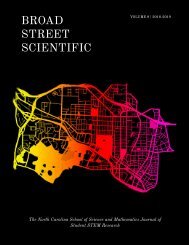Broad Street Scientific Journal 2020
You also want an ePaper? Increase the reach of your titles
YUMPU automatically turns print PDFs into web optimized ePapers that Google loves.
5. Conclusion
In summary, by using an emotional one-back task
allowing for the analysis of the interplay of WM and ER,
we demonstrated between-group differences attributed
to emotional blunting and surprising results for highrisk
participants. Our findings indicate that RO patients
tend to show deactivation/lesser activation in WM and
ER regions, which can be attributed to limited capacity
(and less activation overall), with fewer changes due
to emotional valence. Interestingly, our results suggest
that during an effortful cognitive memory task with no
emotional valence, HR does not fall between CON and SZ
as an intermediate, but instead exhibits greater activation.
Another surprising finding of HR was that less brain
activity was associated with a significant reduction in
CON and RO patients’ performance, while more brain
activity was associated with a significant reduction in HR
participants’ performance. Understanding the WM and
emotional processing deficits in schizophrenia is a critical
target for improving diagnosis and recovery outcomes in
schizophrenia.
6. Acknowledgments
I would like to acknowledge Dr. Andrea Pelletier-Baldelli,
Dr. Aysenil Belger and Mr. Josh Bizzell from the UNC
Department of Psychiatry for their help with understanding
the cognitive side of this project, as well as providing the
data used here, Mr. Robert Gotwals for his guidance during
the research process, and the Research in Computational
Sciences Program at NCSSM.
7. References
[1] Guimond, S., Padani, S., Lutz, O., Eack, S., Thermenos,
H., & Keshavan, M. (2018). Impaired regulation of emotional
distractors during working memory load in schizophrenia.
Journal of psychiatric research, 101, 14–20.
[2] Seidman, L. J., Thermenos, H. W., Poldrack, R. A.,
Peace, N. K., Koch, J. K., Faraone, S. V., & Tsuang, M. T.
(2006). Altered brain activation in dorsolateral prefrontal
cortex in adolescents and young adults at genetic risk for
schizophrenia: An fmri study of working memory. Schizophrenia
research, 85(1-3), 58–72.
[5] Forbes, N., Carrick, L., McIntosh, A., & Lawrie, S.
(2009). Working memory in schizophrenia: A meta-analysis.
Psychological medicine, 39(6), 889–905.
[6] Eryilmaz, H., Tanner, A. S., et al. (2016). Disrupted
Working Memory Circuitry in Schizophrenia: Disentangling
fMRI Markers of Core Pathology vs Other Aspects of
Impaired Performance. Neuropsychopharmacology, 41(9),
2411–2420. doi:10.1038/npp.2016.55
[7] Gray, J. R., Braver, T. S., & Raichle, M. E. (2002). Integration
of emotion and cognition in the lateral prefrontal
cortex. Proceedings of the National Academy of Sciences,
99(6), 4115–4120.
[8] Lang, P. J., Bradley, M. M., Cuthbert, B. N., et al. (1999).
International affective picture system (iaps): Instruction
manual and affective ratings. The Center for Research in
Psychophysiology, University of Florida.
[9] Kring, A. M. [A. M.], & Moran, E. K. (2008). Emotional
Response Deficits in Schizophrenia: Insights From
Affective Science. Schizophrenia Bulletin, 34(5), 819–834.
doi:10.1093/schbul/sbn071
[10] Jenkinson, M., Bannister, P., Brady, M., & Smith, S.
(2002). Improved optimization for the robust and accurate
linear registration and motion correction of brain images.
Neuroimage, 17(2), 825–841.
[11] Smith, S. M., Jenkinson, M., et al. (2004). Advances in
functional and structural mr image analysis and implementation
as fsl. Neuroimage, 23, S208–S219.
[12] Thomas Yeo, B., Krienen, F. M., et al. (2011). The organization
of the human cerebral cortex estimated by intrinsic
functional connectivity. Journal of neurophysiology, 106(3),
1125–1165.
[13] Bang, M., Kim, K. R., Song, Y. Y., Baek, S., Lee, E., &
An, S. K. (2015). Neurocognitive impairments in individuals
at ultra-high risk for psychosis: Who will really convert?
Australian & New Zealand Journal of Psychiatry, 49(5),
462–470.
[3] Kring, A. M. [Ann M], & Elis, O. (2013). Emotion deficits
in people with schizophrenia. Annual review of clinical
psychology, 9, 409–433.
[4] Becerril, K., & Barch, D. (2011). Influence of Emotional
Processing on Working Memory in Schizophrenia. Schizophrenia
Bulletin, 37(5), 1027–1038. doi:10.1093/schbul/
sbq009
32 | 2019-2020 | Broad Street Scientific BIOLOGY




